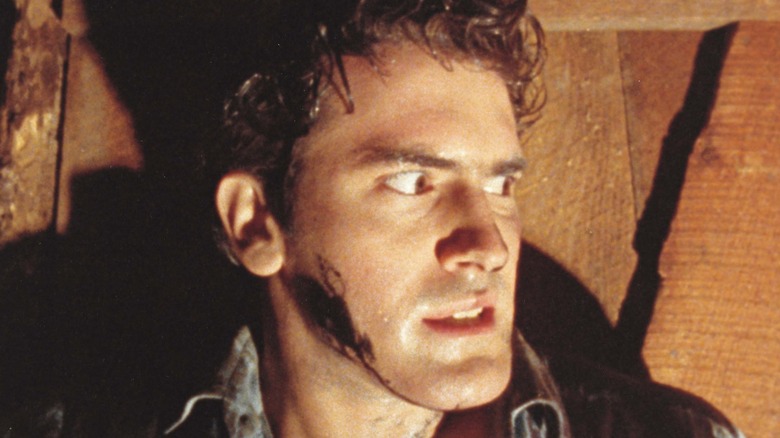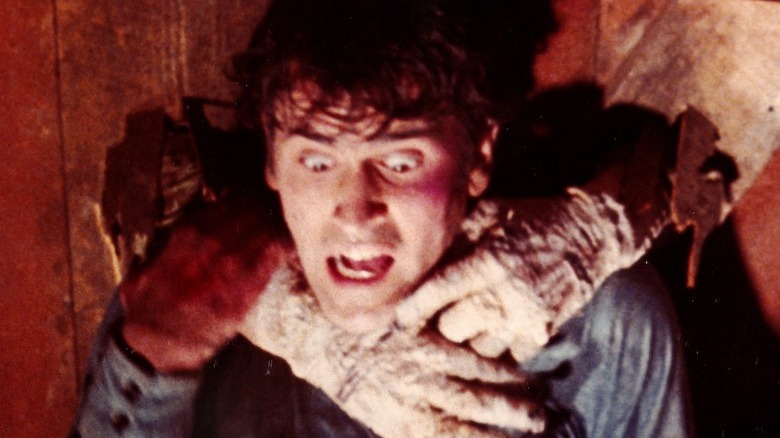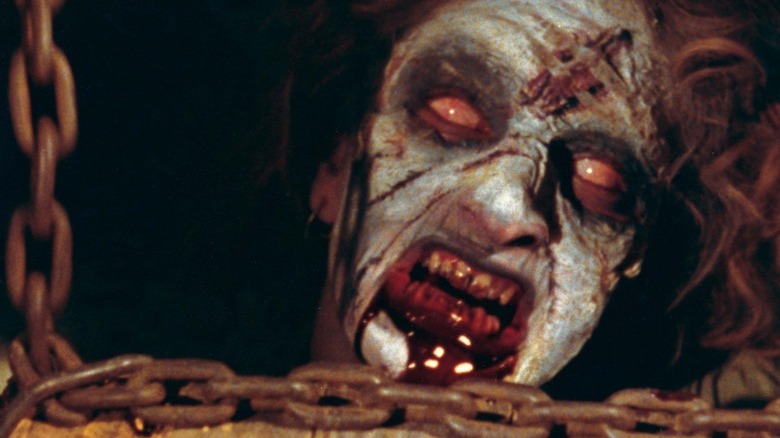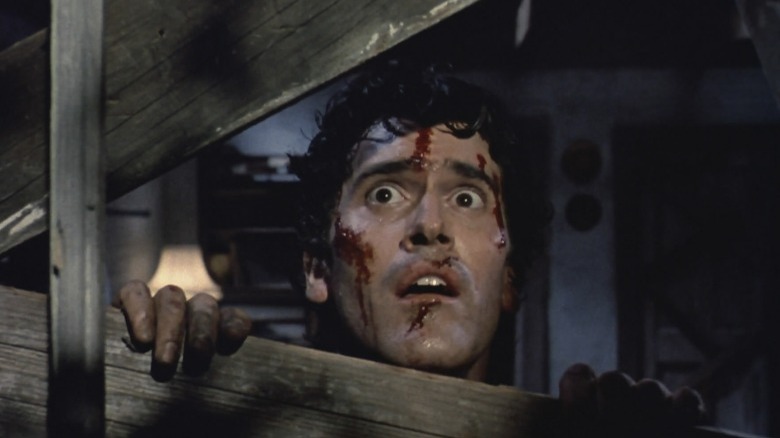The Evil Dead Ending Explained: The Definitive Cabin In The Woods Horror, Even 40 Years Later
In 1978, close friends Sam Raimi and Bruce Campbell, who shared a history of filming low-budget shorts on Super 8 mm, decided to approach the horror genre with newfound zest. With prior experience directing only comedic films, Raimi started working on a proof-of-concept horror short to attract investor attention and cast Campbell and Ellen Sandweiss as its leads. This project was titled "Within the Woods," which followed a group of friends vacationing at a remote cabin in the woods who experience demonic possession and unimaginable horrors. After the short managed to raise enough money from investors, Raimi fleshed out the initial premise into his low-budget, DIY feature-length horror debut, "The Evil Dead." Upon its release, the face of horror changed forever.
From a narrative perspective, "The Evil Dead" relies on traditional horror tropes that often segue into characters making really dumb decisions that eventually seal their fates. Moreover, the central source of threat in the film, i.e. The Book of the Dead, incorporates the oft-used Lovecraftian motif to rather generic ends. Despite these limitations, the triumph of "The Evil Dead" lies in the way Raimi does so much with so little. For instance, a tense atmosphere is evoked in the beginning solely through a swing battering against the wind, and the film's over-the-top practical effects (read: copious amounts of blood and gore) add a fever-dream tint to the events, helping define the mood of Raimi's cabin in the woods horror.
Raimi's final brush stroke, wherein he leads us to believe that Ash Williams (Campbell) is safe at the end only to violently subvert it, drives the brilliance of the film home. Right at the edge of safety and catharsis, Ash is unjustifiably dragged into another hellish experience. So, what's up with that unexpected, frenetic ending?
Ash Williams, a reluctant hero
The final guy/girl trope is a staple in horror, especially the kind where a group is targeted by a deadly threat. This trope has been subverted or reinvigorated to good measure in films like "The Cabin in the Woods," which completely dismantles horror "rules" while paying homage to them. Ash, despite narratively fulfilling the role of the final survivor, continuously undermines the parameters required to achieve that status. Although Ash evolves greatly throughout the franchise, his demeanor in "The Evil Dead" is a far cry from conventional protagonists who survive extreme scenarios in horror movies.
As the film progresses, the audience is made to realize that it's Ash we should be rooting for, even though he doesn't exhibit qualities associated with the final guy. In fact, it is his brash, devil-may-care friend Scott (Richard DeManincor) who does. He proactively fights off Deadites in high-stakes situations and ventures outside to find an alternate escape route. While Scott doesn't hesitate to dismember his possessed girlfriend and subdue Deadite Cheryl (Sandweiss), Ash remains shell-shocked and is initially unable to do what's necessary to survive. However, the reason why Ash survives and Scott doesn't is that the former exhibits compassion even in the face of terror. While Scott's "every man for his own" attitude should've practically saved his life, it doesn't. Ash's predicament emerges as infinitely more nuanced, as he is a reluctant survivor torn between saving his loved ones and butchering them to stay alive.
After Ash succeeds in burning the Book of the Dead, the horrors do not end but mutate. Ash witnesses a horrifying spectacle — guts, blood, and pus exploding out of the Deadites in haunting stop-motion glory — and emerges out of the cabin a changed man. He's been marked, hence hounded in the end despite earning his freedom.
Evil lurks in every corner of Raimi's world
In "The Evil Dead," no one is safe. Apart from unjustified fates, there's jagged-edged cruelty embedded into the narrative, a case in point being the infamous tree assault scene (which has definitely not aged well). While every character suffers disproportionately, Ash undergoes the cruelest of horrors — his inherent goodness and compassion become weapons for the Deadites to trick and manipulate him, which often lands him in situations that are downright heartbreaking. The kind of evil Raimi posits here does not simply frighten with disgusting viscera and milky-possessed eyes. Here, evil lurks in every corner of the film's worldbuilding, waiting to hook its claws into unsuspecting people, who then transform and taunt their loved ones to the point of psychological abuse.
Circling back to the whooshing camera effect that caps off the film, Raimi used this kinetic shaky-cam effect to denote the ever-watching nature of evil, present way before the group accidentally plays Raymond Knowby's tape. Voyeuristic camera angles saturate the first half of the film, where an unseen force watches the group intently and maliciously while influencing their subconscious. For instance, Cheryl, who seems more psychically attuned than others, etches the Necronomicon in a trance and ventures out alone in the woods despite sensing palpable danger. These decisions, apart from being stock horror devices, also function as machinations of the unseen force.
Even the humor in "The Evil Dead" is tainted by terror, granting the film its telltale unsettling quality. The scene in which Deadite Cheryl mocks Scott's pleas for help to Ash is both hilarious and disturbing, as evil adopts a petty, sarcastic tactic to further traumatize its victims. Using every range of emotion in the human experience, the evil in Raimi's world finds a way to get under your skin.
Laying the groundwork for a burgeoning franchise
The highly-anticipated "Evil Dead Rise" is set to expand Raimi's world and reinvigorate the franchise as a whole. The 1981 original was followed by two sequels, with the second installment re-enacting some of the events of the first film to set the stage for Ash's arc, which still elicits confusion in viewers. Ash's fate at the end of "The Evil Dead" might have initially been written as definitive, but the film's overwhelming success opened avenues for an expanding franchise with Ash as its figurehead. The events of "The Evil Dead II" and "Army of Darkness" re-contextualize Ash's fate in the original, who transforms from a conflicted victim of circumstance to a boomstick-wielding badass ready to do what's necessary. By the third entry in the franchise, Ash finally achieves the thoroughly-earned final guy status.
One of the key reasons why the 2013 soft reboot "Evil Dead" worked so well is that the film managed to expand on the original premise in brutal, creative ways. Despite sharing a similar premise, "Evil Dead" takes a gore-heavy approach that complements the setting while expanding the lore in interesting ways. It ends with a post-credits scene that features an older Ash — an unapologetic reminder of who laid the groundwork for those down the line.
Forty years later, Sam Raimi's "The Evil Dead" still manages to scare. Although some elements seem dated, what persists is Ash's nightmarish journey rooted in radical empathy. Ash does not hack his way to survival or abandon his humanity. He fights as hard as he can, traumatized to no end, shaken but never unmoored from his innate compassion. He grieves, he persists, and he does not look away when evil unravels in hideous ways. Now, that's groovy.



